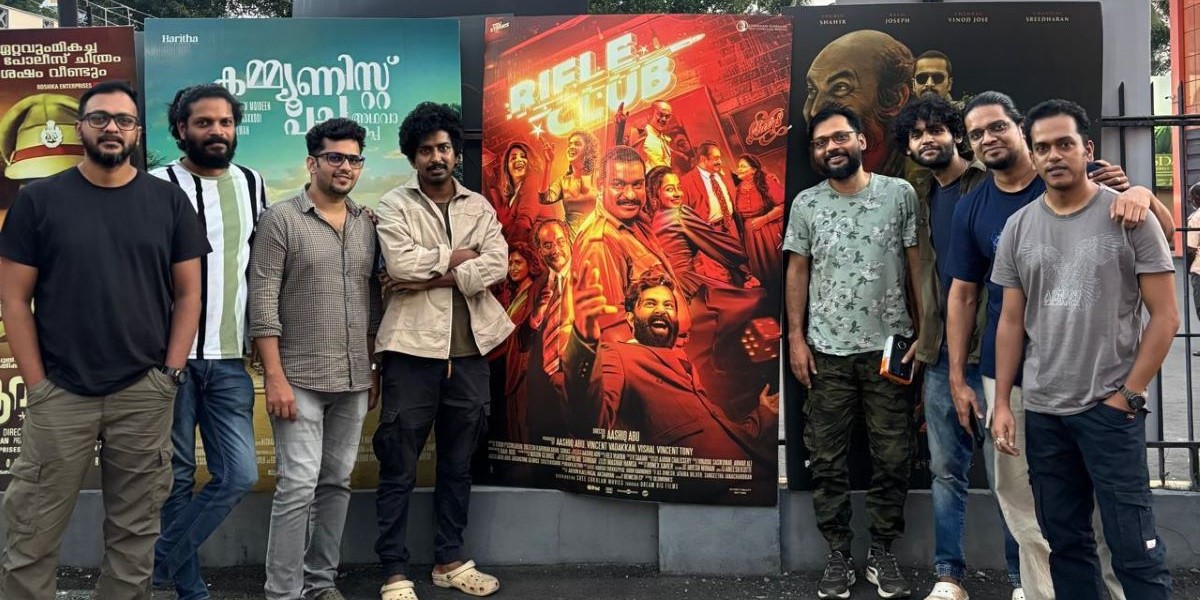The fight sequences of 'Rifle Club' had stylish direction and seamless VFX, enhancing the overall experience. The VFX part was handled by The Little Hippo Studios. The founder of the studios, Aneesh Kutti, in an exclusive conversation with South First, detailed the work that went behind it.
Published Feb 07, 2025 | 12:08 PM ⚊ Updated Feb 07, 2025 | 12:08 PM

Little Hippo Studios team pose for a picture (Supplied)
Aashiq Abu’s last release, Rifle Club, received a warm reception in theatres and on OTT. Apart from the story and performances, the film was widely appreciated for its fight sequences set in a forest at night time.
The fight sequences had stylish direction and seamless VFX, enhancing the overall experience.
The VFX part was handled by The Little Hippo Studios. The founder of the studios, Aneesh Kutti, in an exclusive conversation with South First, detailed the work that went behind it.
The VFX team includes Aneesh Kutti, Govind Sathish, Visakh P. Varma, Vishnu Peethambaran, Shiju P, Sree Visakh R, Abdul Rahim, and Aju Koshy.
Aneesh Kutti was involved in Rifle Club from the start and was familiar with the story. Speaking about the widely discussed tiger-dog scene, Kutti explained that the scriptwriters considered two options, whether it should be a planned, or sudden attack. “We decided on a sudden attack,” he said.
“Many scenes in the movie are set in dark, making it hard to distinguish between VFX and non-VFX. For the tiger-dog attack, we aimed to avoid being too predictable and applied the same approach throughout the film. About 40 minutes of the movie features VFX,” Kutti added.
“We focused on editing out unnecessary VFX shots, ensuring the story took precedence over flashy effects,” he explained.
Speaking more about Rifle Club, Kutti mentioned that the film features many night scenes that were not actually shot in the dark. For instance, the forest scenes where the main characters go hunting were filmed in the morning, but these shots were later converted into night scenes using VFX.
The shooting took place in Rajahmundry because it was raining in Kerala at the time. One major challenge they faced was that the dogs, which were intended for the Kerala portions, couldn’t be transported due to logistical issues. Director Aashiq Abu informed Kutti that there wouldn’t be any dogs in Rajahmundry, so the entire team worked on recreating the scenes involving dogs, tigers, and other relevant elements.
Similarly, some key shots, such as the opening shot depicting Bangalore in the ’90s and other important locations, were created using VFX. The gunshots, gun flares, and bloodshed were also done through VFX.
“We treated those scenes like a ‘Holi’ festival,” Kutti explained. “It’s akin to something like the killing of Ravana.”
The filmmakers were careful with the amount of bloodshed shown, as they didn’t want the film to become overly gory. They were concerned that excessive violence might lead to an ‘A’ certificate, which would limit the movie’s audience, especially among families. “We have to ensure that the film, as an art form, caters to all audiences,” Kutti added.
The movie includes exclusive shots created by the VFX team, along with scenes that were seamlessly blended with actual footage.
Kutti had previously worked with Aashiq Abu on Rani Padmini (2015). In that film, there is a scene where the female lead has a conversation-like moment with an ant, which the director really liked. Kutti has also worked on Oru Thekkan Thallu Case (2022) and Tamaar Padaar (2015).
Little Hippo Studios is currently working on a new project produced by Wayfarer Films. Kutti, who heads the firm, mentioned that there are several innovative projects coming to Malayalam cinema. He shared that their upcoming 3D movie Lovely, which stars Mathew Thomas in the lead role, features a housefly in the title role. This will be the company’s next project, set for release on 4 April.
Kutti believes that in Malayalam cinema, CG work is primarily used to create animals, as animal welfare regulations prevent shooting with real animals. Having previously worked at DreamWorks Studios in Bengaluru, Kutti has now relocated to Kochi to focus more on Malayalam films.
He pointed out that Malayalam cinema is gaining good exposure, and other industries are taking notice due to the strong content it offers. However, there are fewer opportunities for VFX and CG work in Malayalam films. He elaborated that while the Telugu industry has successfully incorporated VFX into its films, Malayalam cinema, known for its content-driven narratives, hasn’t yet embraced VFX-driven films.
Kutti believes this is mainly because stories in Malayalam are not typically written in a way that lends itself to VFX. For example, superhero films are not commonly written here, and even if someone attempts to do so, the fear of budget constraints holds them back.
Little Hippo Studios employs people with experience from international studios, and Kutti, who leads the firm, is committed to bringing more films with animated characters in lead roles to Malayalam cinema. “We started our firm to make this happen and to work towards it,” he said.
Kutti also emphasized that while animated Hollywood films are made with budgets of around ₹2500 crores, Malayalam animation films can be produced at a much lower cost.
(Edited by Sumavarsha)
